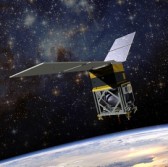 NASA has completed a series of environmental and functional tests on software and systems in a Ball Aerospace & Technologies-built spacecraft designed to demonstrate a green propellant alternative to hydrazine.
NASA has completed a series of environmental and functional tests on software and systems in a Ball Aerospace & Technologies-built spacecraft designed to demonstrate a green propellant alternative to hydrazine.
The space agency plans to launch in 2017 the Ball Configurable Platform-100 small satellite in an effort to carry and demonstrate the AF-M315E fuel as part of its Green Propellant Infusion Mission, NASA said Thursday.
The Air Force Research Laboratory developed the AF-M315E propellant, while Aerojet Rocketdyne built the thrusters and the propulsion subsystem for the spacecraft.
“The GPIM spacecraft will go into storage for a few months and the team will focus on the propellant’s handling and loading campaign,†said Chris McLean, principal investigator for GPIM and a staff consultant at Ball Aerospace and Technologies.
BCP-100 is scheduled to lift off onboard the SpaceX-built Falcon Heavy launch vehicle in 2017 as well as bring three Defense Department-supplied experimental payloads into orbit.




